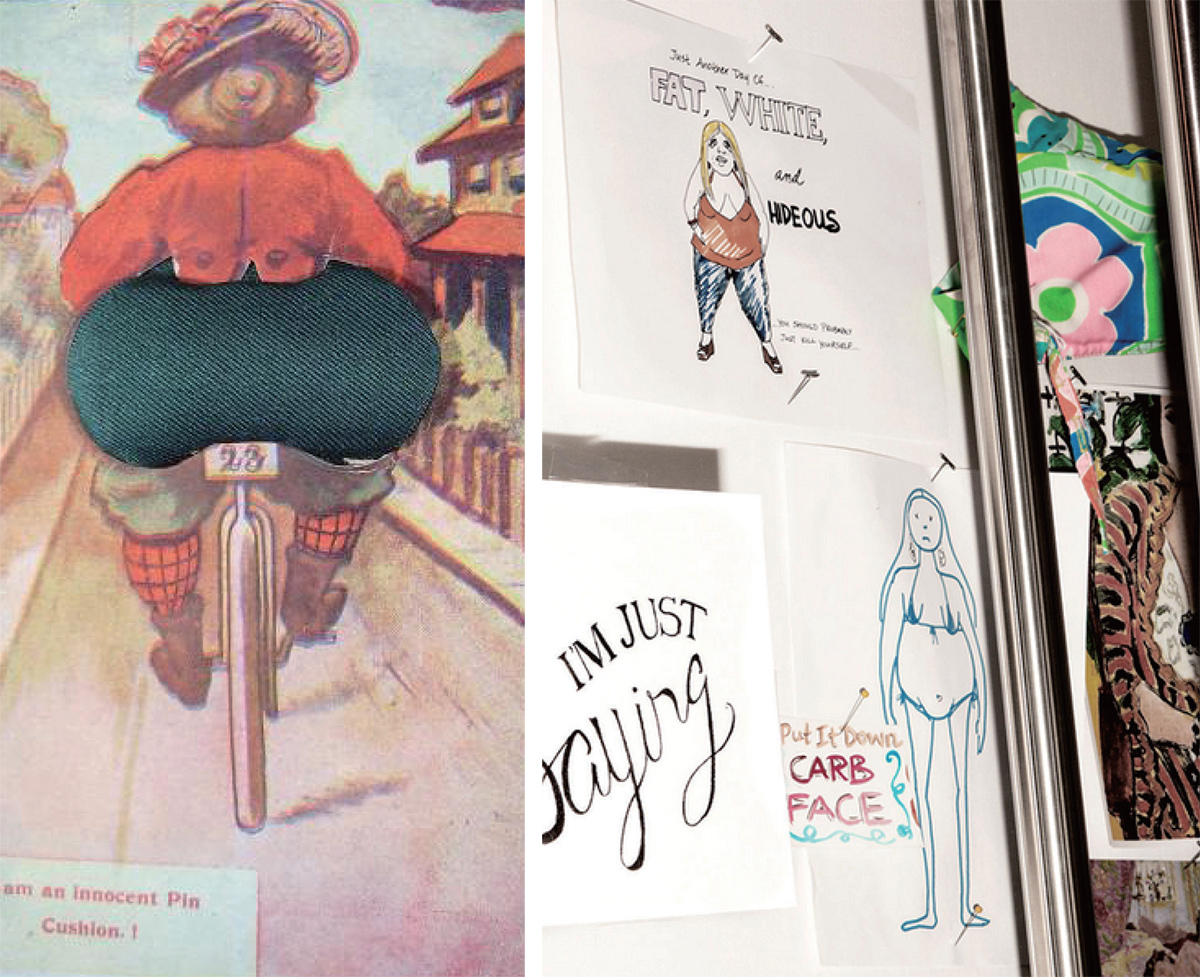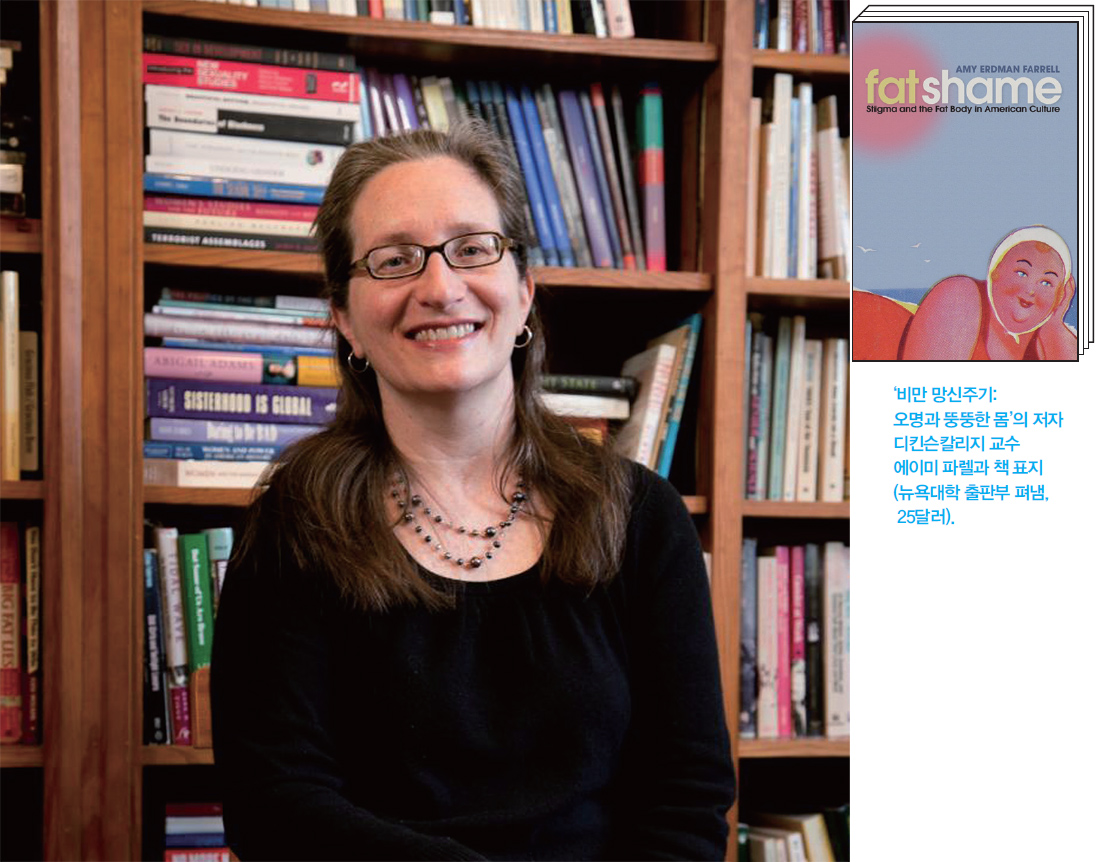- 여성에게 더 가혹한 비만의 굴레

BODY-SHAMING, A HISTORY
Author talks thigh gaps, ‘dad bods’ and why we hate fat.When body-shaming cartoons that a Lilly Pulitzer employee posted near her cubicle went viral on Wednesday, the Internet exploded with self-righteous indignation. But as Dickinson College professor Amy Farrell’s book “Fat Shame: Stigma and the Fat Body” (NYU Press, 2011) makes clear, fat- and body-shaming can be traced back to mid-19th century England, when the first modern dieting book was published.
While fat became public enemy number one, it was women’s bodies that largely became the site of cultural, racial and class anxieties of which fat phobia is a sign. These anxieties and their contradictions are alive today, in a culture that, on one hand, tells women that “Nothing tastes as good as skinny feels” and celebrates “thigh gaps” in photos. On the other hand, it tells women that it’s the age of the butt or that they need large breasts -- not often found (naturally) on ultra-thin bodies.
Men, meanwhile, get to have “dad bods.”
“Having a superior body is how we demonstrate we’re superior,” Farrell told International Business Times. “Culturally, there becomes a whole group of people who aren’t superior: the fat people, which links up to race, class and gender. We don’t call it that, though; we say we want to be healthier.”
The very same behaviors that would identify a thin person as having an eating disorder, Farrell noted -- restricting food, obsessive attention to diet and exercise, obsessive attention to body weight -- is what gets “prescribed” for a fat person. (She writes more about this “Fat Chance: The Line Between Health and Shame Is Becoming Increasingly Thin.”)
How did you start writing about fat-shaming?
I work on the history of women and feminism, and had just completed a history of Ms. magazine. I was looking for another subject, and began researching the history of dieting. It got pretty boring. There have been milk, all-protein, grapefruit diets going back to the 19th century. What was interesting was how all the diets talked about fat.
I thought the dieting industry started in 1920s. It looks like that because there were so many ads for diets then. But it started among middle-class white people -- with the growth of the middle class. Fat was the evil antagonist, the sign of an uncivilized and “primitive” body. It was linked with “scientific” racism that [attempted] to prove that African people and indigenous people were inferior. One sign? Fat: the atavistic, primitive trait. And it continues today. I’m not surprised that someone would have those pictures up at Lilly Pulitzer.
So if the fear of fatness is related to racism, can we assume that because Jennifer Lopez and Beyonce’s bodies are idealized, particularly their backsides, and women are even getting butt implants to emulate them, that there’s no longer a connection between certain races and ethnicities with fat?
It [privileging of bigger backsides] is connected [to that racist discourse]: a sign of wild sexuality. I would argue it’s same thing. Because the butt still has to be shaped in a particular way. If we go back in time, the bustle would have been the same thing: over your skin, instead of under.
It’s like tanned skin. It’s ironic that it has been historically a sign of wealth and beauty, because dark skin is often seen as inferior. It’s a desirable thing if kept within its bounds. It’s like the difference between a “redneck” versus a bronzed beauty, whose tanned skin would be a sign of her elite status, a sign of leisure.
Did you see shifts in body types over the 20th century? Were there reasons?
I found less a shift than an increasing, strengthening feeling about fat. It’s rather that one strand took hold more strongly. In the middle of the 19th century, fat was suspect. It was still a sign that you’re healthy and fertile, well-to-do. But for men, the “fat cat” had a lot of power. Just think of images of a man with a big belly and pocket watch, like the horrible banker Potter in “It’s A Wonderful Life.”
What became increasingly the case, for middle-class people aspiring to a higher standard of living, was that the thin body was important. Thinness proved one was disciplined, civilized. That became increasingly true. A few presidents were fat, but it’d be harder to be a fat president now. Grover Cleveland was teased for being fat.
What were some signs of the shift to fat-shaming and fat-phobia in the mid 19th century?
The first diet book was published in England, in mid 19th-century. And in the late 19th century and into the 20th century, you started seeing “fat women” postcards. Dieting materials from that period were addressed to white men, saying to them, “We know that in less civilized, primitive cultures, fat women are considered beautiful. We are not Hottentots or Moors. For us, a fat body doesn’t hold an allure.” What’s interesting was that it was teaching white men to not like fat women. It’s like the attractiveness of fat women had to go underground.
Who was buying these postcards?
They were postcards people would pick up at tourist sites. Instead of texting, they’d send postcards they bought at the corner pharmacy. The postcards were like memes today. The postcards would show a fat butt, sometimes as a pincushion. Joking about the fat butt goes way back, back to the “science” surrounding African people and the Venus Hottentot. [Saartjie Baartman was the so-called Hottentot Venus, a woman whose large buttocks caused her to be exhibited as a “sexual freak-show attraction” in 19th century Europe.] After she died, Doctor Georges Cuvier dissected her body to see that she was human, and wasn’t a missing link between beast and people. And it was because of her fatness. Those buttocks were enticing and interesting, and read as a sign of primitiveness.
And before mid-19th century? Was fat OK?
Having a little plumpness was a sign of fertility, wealth. Diseases like tuberculosis made you thin. Thinness has been about not crossing a line. I didn’t see evidence of a time when fatness was celebrated. I wanted to find it, but I haven’t seen it.
Did fat-shaming apply equally to men and women?
The father of the diet movement, William Banting, was upset about his own body being fat. It’s not that men have been outside the diet industry or its pressures, but the most public ridicule and emphasis has fallen and continues to fall on women’s bodies. There’s more of a window for men’s bodies. They can become bigger before crossing into unacceptability. There’s no cultural place for her to take up a lot of place, but taking up space is considered a right for men.
I would never want to say men are immune, though. Chris Christie had weight-loss surgery, and he doesn’t seem the type to worry about taking up space. But there is cultural pressure on the national stage to get the body “under control.” But when it comes to the weight-loss industry -- surgery, diets, diet products -- it’s mostly women. And they’re getting younger and younger. It’s like the person’s fat body doesn’t have a right to exist.
Just recently, we were all told that “dad bods,” bodies of men that seem to work out a little bit but still have a gut, are in. We don’t hear much about “mom bods.”
It’s connected to the “allowance” men get to take up more space, for example, “manspreading.” Fatness in men, up to a certain level, allows them to be “Everyman,” human, approachable. There’s more of an allowance for men than there is for women.
Is there a cultural driver for moments when thin is more in? Like in the 1920s with the flapper’s body, or Twiggy in the 1960s -- or now, compared to the supermodels of the 1980s, when size 6 was considered OK?
Even size 6 is very little. It seems that the more rights women got, there was a cultural pressure for size to go down. Thinness as sign of civilized body. People often talk about “healthiness,” but it’s really a cultural anxiety about the fat body. People know they’re discriminated against, so they’ll do a lot: Diet pills, surgery. There are complications from what happens to their bodies after surgery. They can’t absorb nutrients and even become malnourished.
I also think money is factor. We have a $67 billion diet industry. That works because people hate their bodies.
여성에게 더 가혹한 비만의 굴레

미국 디킨슨칼리지 에이미 파렐 교수의 역사적인 고찰, “19세기 중반부터 가냘픈 몸매가 문명화의 상징”지난 5월 27일 패션하우스 릴리퓰리처 본사 사무실 벽에 한 직원이 비만을 조롱하는 만화를 붙였다. 그 사진이 트위터를 통해 널리 퍼져나가면서 인터넷은 자칭 ‘의인’들의 분노로 폭발했다. 그러나 미국 디킨슨칼리지의 에이미 파렐 교수가 2011년에 출간한 책 ‘비만 망신주기: 오명과 뚱뚱한 몸(Fat Shame: Stigma and the Fat Body)’이 지적하듯 비만인 폄훼 현상은 현대 다이어트 책이 처음 발간된 19세기 중반 영국까지 거슬러 올라간다.
요즘 비만이 공적 1호가 됐지만 그 대상은 주로 여성이다. 우리 문화는 여성에게 늘씬한 몸매와 ‘허벅지 틈새(thigh gaps, 다리와 무릎을 붙이고 섰을 때 허벅지 사이에 생기는 틈)’를 요구한다. 그러면서도 풍만한 둔부와 가슴을 갈망하는 모순도 보인다. 반면 남성은 ‘아버지 몸(dad bods, 근육질은 아니지만 어느 정도 운동으로 건강을 유지하는 몸)’이 장려된다. 파렐 교수를 만나 우리가 비만을 혐오하는 이유를 들어봤다.
비만 폄훼에 관해 책을 낸 동기는?
페미니즘의 역사를 공부하면서 다이어트의 역사도 연구했다. 하지만 지루했다. 우유, 단백질, 자몽 다이어트는 19세기부터 시작됐다. 흥미로운 점은 이 모든 다이어트의 공격 목표가 비만이었다는 사실이다. 다이어트 산업은 1920년대 영국에 시작된 듯하다. 당시 다이어트 광고가 많이 나왔다. 특히 중산층이 늘면서 백인 중산층 사이에서 다이어트가 유행했다. 비만은 ‘사악한 적’이었다. 미개하고 ‘원시적’인 몸의 상징이었다. ‘과학적’ 인종차별과도 연관됐다. 아프리카인과 아메리카 원주민이 열등하다는 점을 입증하려는 시도였다. 지금도 마찬가지다. 릴리퓰리처 사무실에 그런 그림이 나붙은 것도 어쩌면 당연할지 모른다.
비만 혐오가 인종차별과 관련 있었다면 요즘은 백인이 아닌 제니퍼 로페즈와 비욘세의 몸매(특히 엉덩이 부분)를 여성이 부러워한다. 그렇다면 지금은 특정 인종과 비만의 상관관계가 사라졌나?
풍만한 둔부도 인종차별주의와 연결된다. 야성적 섹시함의 상징이라는 뜻이다. 과거 여성이 치마 뒷부분을 불룩하게 하기 위해 걸쳤던 치마받이 틀도 마찬가지였다. 몸이 아니라 옷이라는 점만 다를 뿐이다. 햇볕에 그을린 피부도 마찬가지다. 그런 피부가 역사적으로 풍요와 아름다움의 상징이었다는 게 역설적이지 않은가. 어두운 피부색은 열등함과 연결되는 경우가 많기 때문이다.
20세기 들어 사람들이 선호하는 몸매에 변화가 있었나?
변화라기보다 비만에 관한 시각이 굳어졌다고 말해야 옳을 듯하다. 19세기 중반엔 비만이 조롱을 받았지만 여전히 건강과 생식력, 부의 상징이었다. 남성의 경우 ‘뚱뚱한 고양이(fat cat, 배부른 자본가)’는 권력을 상징했다. 영화 ‘멋진 인생’의 은행가 포터처럼 배가 나오고 회중시계를 가진 남자를 보라. 그러나 시간이 흐르면서 더 높은 생활수준을 바라는 중산층은 날씬한 몸이 중요하다고 생각하기 시작했다. 날렵한 몸이 자제력 있고 문명화의 상징으로 인식됐다. 과거 미국엔 뚱뚱한 대통령도 있었지만 지금은 그렇지 않다.
19세기 중반 비만을 조롱하고 혐오하게 된 계기는?
첫 다이어트 책이 19세기 중반 영국에서 발간됐다. 19세기 말과 20세기 초엔 ‘뚱뚱한 여성’을 조롱하는 엽서가 등장했다. 당시엔 다이어트 홍보물이 백인 남성을 대상으로 이렇게 말했다. “미개한 문화에선 뚱뚱한 여성이 아름답다고 생각했다. 하지만 우리는 아프리카의 호텐토트족이나 무어족이 아니다. 우리에겐 뚱뚱한 몸이 전혀 매력적이지 않다.” 그처럼 백인 남성에게 여성의 비만을 혐오하라고 종용했다는 점이 흥미롭다.
그런 엽서를 누가 샀나?
주로 관광지에서 팔았다. 당시엔 문자 메시지 대신 관광지에서 구입한 엽서를 보내는 것이 유행이었다. 그 엽서는 풍만한 둔부를 강조했다. 풍만한 둔부를 주제로 한 우스갯소리는 그 당시로 거슬러 올라간다.
19세기 중반 이전에는 비만을 보는 시각이 긍정적이었나?
약간 뚱뚱한 몸은 생식력과 부의 상징이었다. 결핵 같은 질병에 걸리면 살이 빠졌다. 깡마른 몸은 비정상적임을 의미했다. 그러나 비만을 추켜세우지도 부정적으로 보지도 않았다.
비만인 폄훼는 남녀 모두에게 똑같이 적용됐나?
최초의 다이어트 책은 1862년 영국의 장의사였던 윌리엄 밴팅이 쓴 ‘뚱보들에게 보내는 편지(Letter on Corpulence, Addressed to the Public)’였다. 그는 자신의 비만을 혐오해 다이어트를 시작했다. 남성도 다이어트나 체중 감량 압력을 받았지만 공개적인 조롱과 다이어트 압력은 주로 여성에게 집중됐다. 지금도 마찬가지다. 우리 사회는 남성의 몸에는 어느 정도 관대하다. 하지만 과도한 비만은 남성도 지탄 받는다. 특히 전국을 무대로 하는 정치인의 경우 체중을 조절하라는 문화적 압력이 강하다. 그러나 체중 감량과 다이어트 산업은 거의 전부 여성을 대상으로 한다. 다이어트를 하는 나이도 점점 내려간다. 뚱뚱한 여성은 사회에서 설 자리가 없다.
최근 들어 ‘아버지 몸(dad bods)’이 유행이다. 운동을 좀 하지만 여전히 배가 나온 중년 남성의 몸을 말한다. 하지만 ‘어머니 몸(mom bods)’이란 듣지 못했다.
남성은 자리에 앉을 때 공간을 많이 차지해도 괜찮다는 인식과 관련 있다. 예를 들어 남자는 다리 벌리고 넓게 앉는 것이 허용된다. 영어 표현에 ‘manspreading’라는 게 바로 그런 의미다. 하지만 여성은 그런 대접을 받지 못한다.
날씬함이 인기가 높은 문화적 요인이 있나?
지금은 여윈 몸이 문명화의 상징이다. 사람들은 걸핏하면 ‘건강’을 들먹이지만 뚱뚱한 몸에 관한 한 문화적 불안감이 있다. 그래서 여성은 차별 받기 싫어 약이나 수술로 몸을 줄인다. 하지만 특히 수술은 부작용이 많다. 영양소를 섭취 못해 영양실조에 걸릴 수 있다. 돈도 한 가지 요인이다. 미국의 다이어트 산업은 670억 달러(약 74조원) 규모다. 그런 산업은 여성이 자신의 뚱뚱한 몸을 혐오한다는 점을 이용한다.
- 번역 이원기
ⓒ이코노미스트(https://economist.co.kr) '내일을 위한 경제뉴스 이코노미스트' 무단 전재 및 재배포 금지










![갓 잡은 갈치를 입속에... 현대판 ‘나는 자연인이다’ 준아 [김지혜의 ★튜브]](https://image.isplus.com/data/isp/image/2025/11/21/isp20251121000010.400.0.jpg)
![딱 1분… 숏폼 드라마계 다크호스 ‘야자캠프’를 아시나요 [김지혜의 ★튜브]](https://image.isplus.com/data/isp/image/2025/11/09/isp20251109000035.400.0.jpg)



당신이 좋아할 만한 기사
브랜드 미디어
브랜드 미디어
은행 대출금리에 '법적비용' 전가 못한다…위반시 행정제재
세상을 올바르게,세상을 따뜻하게일간스포츠
일간스포츠
이데일리
변요한♥티파니 영, '애정 가득' 자필 편지
대한민국 스포츠·연예의 살아있는 역사 일간스포츠일간스포츠
일간스포츠
일간스포츠
`광주 도서관 붕괴` 시공사 압수수색, 관계자 출국금지…수사 속도(종합)
세상을 올바르게,세상을 따뜻하게이데일리
이데일리
이데일리
불닭볶음면이 만든 1조 매출…삼양식품 신용등급도 상승세
성공 투자의 동반자마켓인
마켓인
마켓인
[용호상박 K바이오] ADC ‘항체’ 기반 지놈앤컴퍼니와 에임드바이오
바이오 성공 투자, 1%를 위한 길라잡이팜이데일리
팜이데일리
팜이데일리